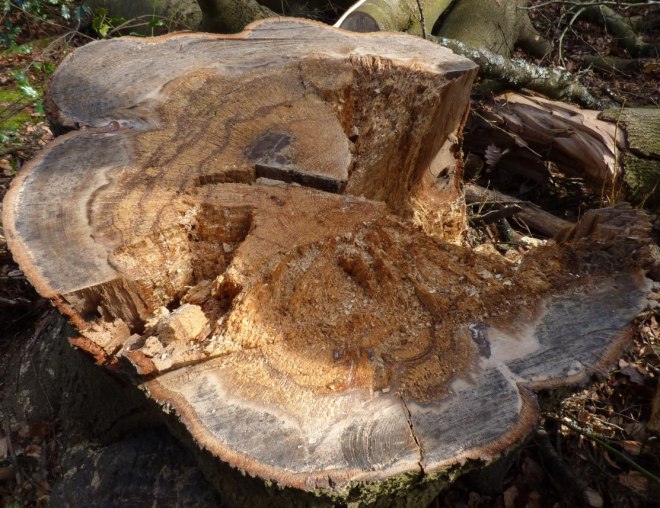A huge thanks to Burnham Beeches yesterday for hosting some of us for the day and showing us around the site. Below are some of the stand-outs from the day, which I am certain you will all appreciate!
The importance of functional units
As we can see in the below few images of a particularly striking beech pollard, very little of the structure of the tree needs to remain for the tree to persist as a living and functional organism. In this example, only one unit of vascularity supports a very small crown, though the beech is generally without significant fault. It could, potentially, persist in this state for many decades! Certainly, the two natural ‘props’ that support the crowd through a sort of tripod could, in their eventual failure, be the demise of this tree; assuming the functional unit cannot itself adequately support the crown. Depending on the rate of decay of this two ‘props’, this last vascular strip might (if decay is slow) – or might not (if the ‘props’ fail sporadically) – be able to lay down the necessary wood fibres for such mechanical support.



Reduction work on lapsed pollards
There comes a point where one has to make a decision – for what reason is a lapsed pollard being managed? If it is to be managed for the provision of habitat then the major failure of the structure might not be an adverse occurrence (to a degree!), though if the intent is to retain the pollards for as long a period as is at all feasible then it might be necessary to undertake quite extensive reduction work, in order to reduce the mechanical loading upon the old pollard head. As can be seen from the below beech, heavy reduction work has taken place and the crown architecture / good number of ripe buds that remain below the pruning points will hopefully ensure that this lower crown will function very effectively. Of course, where lapsed pollards don’t have this lower growth then a heavy reduction might not even be possible, though where such low growth exists then it does provide for more effective means of management, with regards to reduction work of the crown.


Submerged deadwood for reptiles
A terrapin uses a large section of a mostly-sunken stem for sunbathing, in the centre of a large pond. Indeed, this section of deadwood is an effective tool for the terrapin, which allows it to be exposed to direct sunlight and isolated from potentially aggressive mammals (that includes humans – seriously). Improving the texture and heterogeneity of this aquatic habitat with deadwood is evidently important, therefore!


Artificial propping
As some of the old beech pollards are quite literally falling apart, safeguarding their structures against such cataclysmic failure is necessary, if their presence in the landscape is to be retained. For some, this involved reduction work, whilst for others it involves installing props to support either the enture tree or large / heavy parts of its structure. In the below two cases, we can see how props have been installed to stop the trees falling over completely.


Wood-decay fungi
As you’d very much expect from a place such as this, wood-decay fungi are found in relative abundance. Beneath, the best examples are shown – this includes less common fungi, which we also came across during the trip; or less common associations, as you’ll see for one particular set of photos!
Fomitopsis pinicola (red-banded polypore)
Along the stem of a beech, this single bracket of a very infrequently found (in the UK, anyway) wood-decay fungus, the red-banded polypore, resides. Adjacent to a colony of Bjerkandera adusta and above extensive swathes of Kretzschmaria deusta, exactly to what degree this fungus has secured the wood substrate is unknown, though the good thing is that it has produced a fruiting body and in sporulating!


Heterobasidion annosum (fomes root rot)
A common fungus but probably not one you see every day on hawthorn! Hidden beneath a branch ridden with Fuscoporia ferra (syn: Phellinus ferreus) and some leaves, a series of fruiting bodies were tucked away comfortably. Fungi love to throw curve-balls!



Ganoderma pfeifferi (bees-wax polypore)
Sadly, the host beech had recently failed, due to the decay caused by this fungus. With respect to the rot induced, the failure was seemingly a brittle one and thus the failure can be attributed to a significant loss of cellulose. The cross-section of the failed region also yielded some glorious ‘rosing’ patterns, which is something that has been seen in other cases of failure as caused by this particular fungus.



Fomes fomentarius (hoof fungus)
Found on both birch and oak, this species isn’t notably abundant in the south of England, where the pathogens Ganoderma australe / resinaceum / pfeifferi (in order of commonality) tend to be better suited. In the two instances shown below, fallen deadwood has provided the resource, which aligns with its colonisation strategy – that of awaiting stress / entire vascular dysfunction of an area or whole tree, before launching wide-scale colonisation activities.





Daedalea quercina (Oak mazegill)
Found quite frequently on dysfunctional wood of oak, this instance has provided the best sight yet of this species. As you can see, an oak monolith is utterly littered with fruiting bodies, which is genuinely a spectacular sight!








That’s all for today, folks!





















